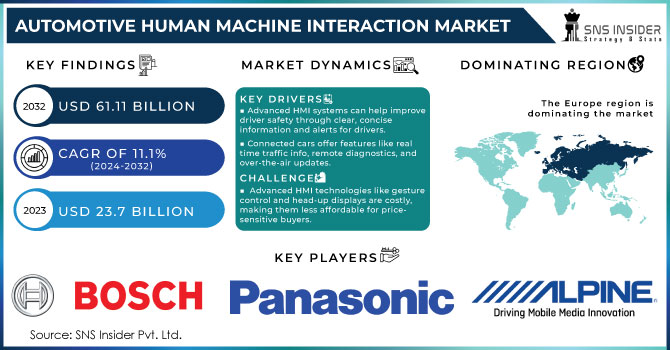Pune, July 12, 2024 (GLOBE NEWSWIRE) -- The Automotive Human Machine Interaction Market to grow at a CAGR of 11.1% and is projected to reach USD 61.11 billion by 2032.

Get a Sample Report of Automotive Human Machine Interaction Market @ https://www.snsinsider.com/sample-request/2775
Study by the National Highway Traffic Safety Administration (NHTSA) shows that driver distraction contributes 10% of all fatal crashes.
Making it necessary to develop automotive human machine interaction systems that minimize distractions, with voice commands enjoying a 72% rise in adoption according to the Society of Automotive Engineers (SAE) survey conducted in 2022. User experience is also a major driver. According to China Automotive Technology Research Center (CATARC), consumers who are intuitive and friendly with their interfaces make up 86%, indicating a move towards a human machine interaction system which can be easily learnt and operated on.
These trends together with AI advances and increasing demand for connected vehicles set-up an exciting future for the automotive human machine interaction market centered around safer and enjoyable driving experiences.
Automotive Human Machine Interaction Market Report Scope & Overview:
| Report Attributes | Details |
| Market Size in 2023 | USD 23.7 |
| Market Size in 2032 | USD 61.11 |
| CAGR (2024-2032) | 11.1% |
| Report Scope & Coverage | Market Size, Segments Analysis, Competitive Landscape, Regional Analysis, DROC & SWOT Analysis, Forecast Outlook |
| Market Driver |
|
Do you need any customization research on Automotive Human Machine Interaction Market, Speak to Our Analyst @ https://www.snsinsider.com/enquiry/2775
Opportunity Landscape:
Nowadays, 72% of drivers express dissatisfaction over vehicle technology that doesn’t provide for individual preferences. How about an automotive human machine interaction which learns your regular commute, adjusts navigation and climate settings automatically as well as suggests cafes close by depending on when you normally take your coffee breaks. This could not only increase driver satisfaction but also create new revenue streams.
Another method of providing in-car recommendation systems for restaurants or entertainment can be through subscription services that are beneficial to both drivers and car manufacturers. The automotive human machine interaction can evolve from a simple interface into a proactive companion by leveraging user data ethically and securely, resulting in an improved overall driving experience.
Finding a balance between innovation and driver focus will be the major barrier for automotive human machine interaction market.
However, voice commands and gesture recognition can also increase cognitive load and distract the driver from his or her road. It is difficult to evaluate mental strain and create a safe as well as intuitive design for automotive human machine interaction. Button presses that were used traditionally do not work with touchscreens or voice interactions. Moreover, driver expectations vary largely depending on age, culture background, and technological fluency.
Key Market Segmentation Analysis:
Central display systems held the highest market share at more than 55% in 2023 however, there appears to be a trend toward diversification. As projected by 2032, luxury and mid-price passenger cars will have adopted head-up displays (HUDs) at an unprecedented rate of almost 15%. This can be because HUDs show important information on windscreen minimizing driver distraction. In contrast, the economy segment considers standard interfaces most important because the cost budgets are limited.
North American automotive human machine interaction market is embracing voice-controlled interfaces and large high-resolution displays at an unprecedented rate.
It seeks to satisfy premium driving experiences accustomed demographic. On the contrary, Southeast Asian subcontinent with a rising number of motor vehicle’s adoption lay emphasis on price and connectivity. Automotive human machine interaction solutions in these regions concentrate on smartphone integration and low-priced touch screens thus reflecting alignment with technologically informed budget –minded consumer-bases.
Buy an Enterprise User PDF of Automotive Human Machine Interaction Market Outlook Report 2024-2032 @ https://www.snsinsider.com/checkout/2775
Key Trends:
There is a significant transformation going on in the automotive human machine interaction landscape, and it is tending towards more immersive and personalized experiences. For instance, multimodal interfaces are becoming increasingly popular to enable drivers communicate with the car using speech, touchscreens or even gestures which ensure that the interaction between the user and the system is more natural and intuitive. It makes the experience of operating vehicles as naturally peculiar as possible hence keeping human beings from getting distracted and improving on security as well.
Recent Developments:
- Bosch partnered with Rightware, they are putting together the hardware expertise of Bosch and software prowess of Rightware to jointly develop next-generation automotive human machine interaction solutions.
- General Motors introduced Hummer EV which for the first time used Unreal Engine from Epic Games, famous as a game development platform noted for its lifelike graphics. This indicates a turn toward automotive human machine interaction that emphasizes not only functionality but also an engaging user experience, similar to popular video games.
Key Takeaways:
- Voice recognition leads the way here by giving accuracy in carrying out commands and minimizing distraction to the driver.
- On the other hand, multimodal interfaces, which fuse voice command with touch, gesture or even biometrics are evolving towards more instinctive user experiences.
- Although there is a concern about potential distraction according to some studies, augmented reality head-up displays (AR HUDs) have become quite popular.
- However, this trend is indicative of automotive human machine interaction systems that keep drivers look at these roads but give a wider range of information and entertainment features.
- Personalization and driver need driven by developments such as artificial intelligence and machine learning are expected to be major catalysts for market growth in years ahead.
Access Complete Report Details @ https://www.snsinsider.com/reports/automotive-human-machine-interaction-market-2775
About SNS Insider
At SNS Insider, we believe that businesses should have access to the best market intelligence and insights, regardless of their size or industry. That's why we offer a range of solutions tailored to meet the unique needs of each client, from startups to big corporations. With a passion for our work and an unwavering commitment to delivering value, we are dedicated to helping our clients achieve their full potential.
